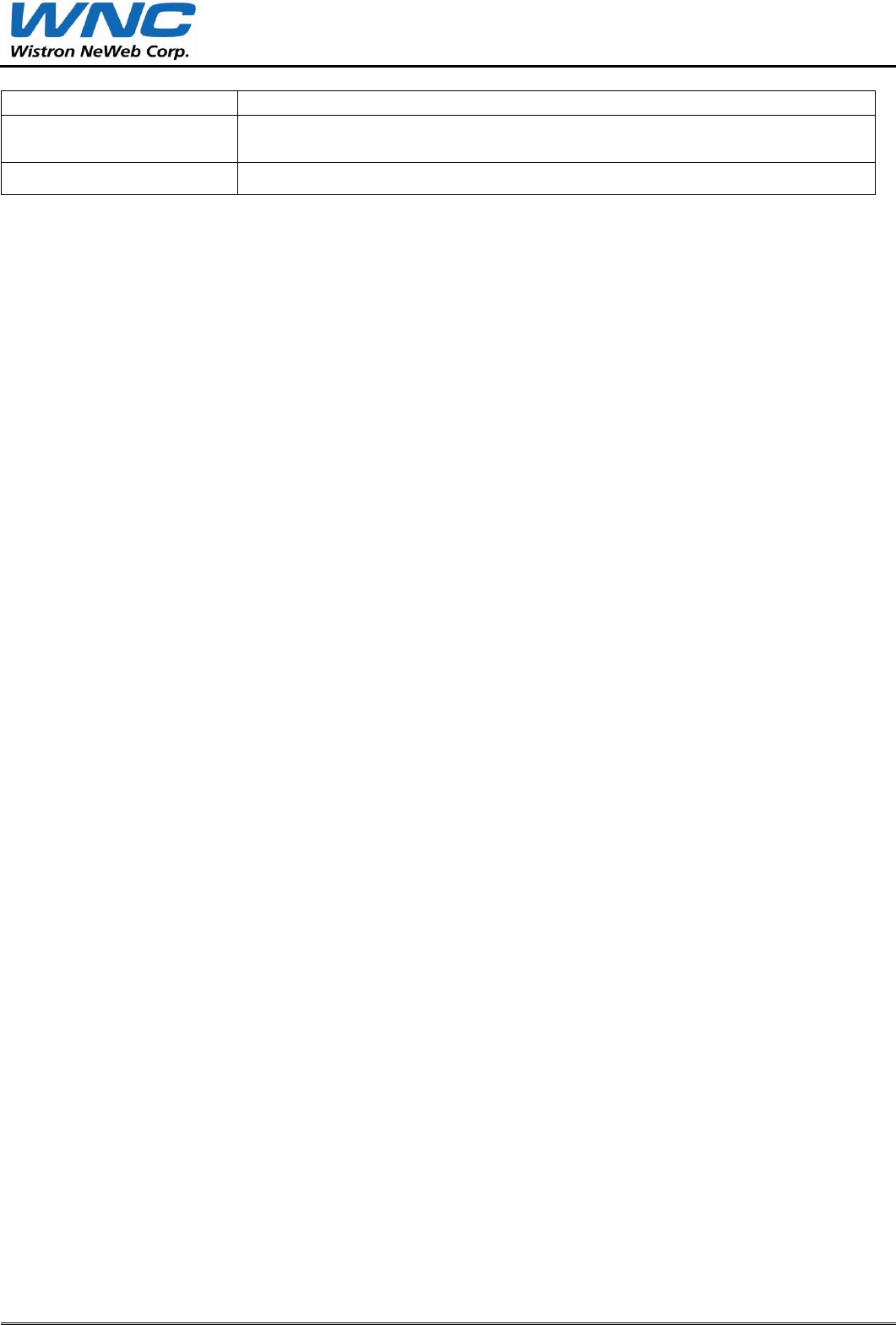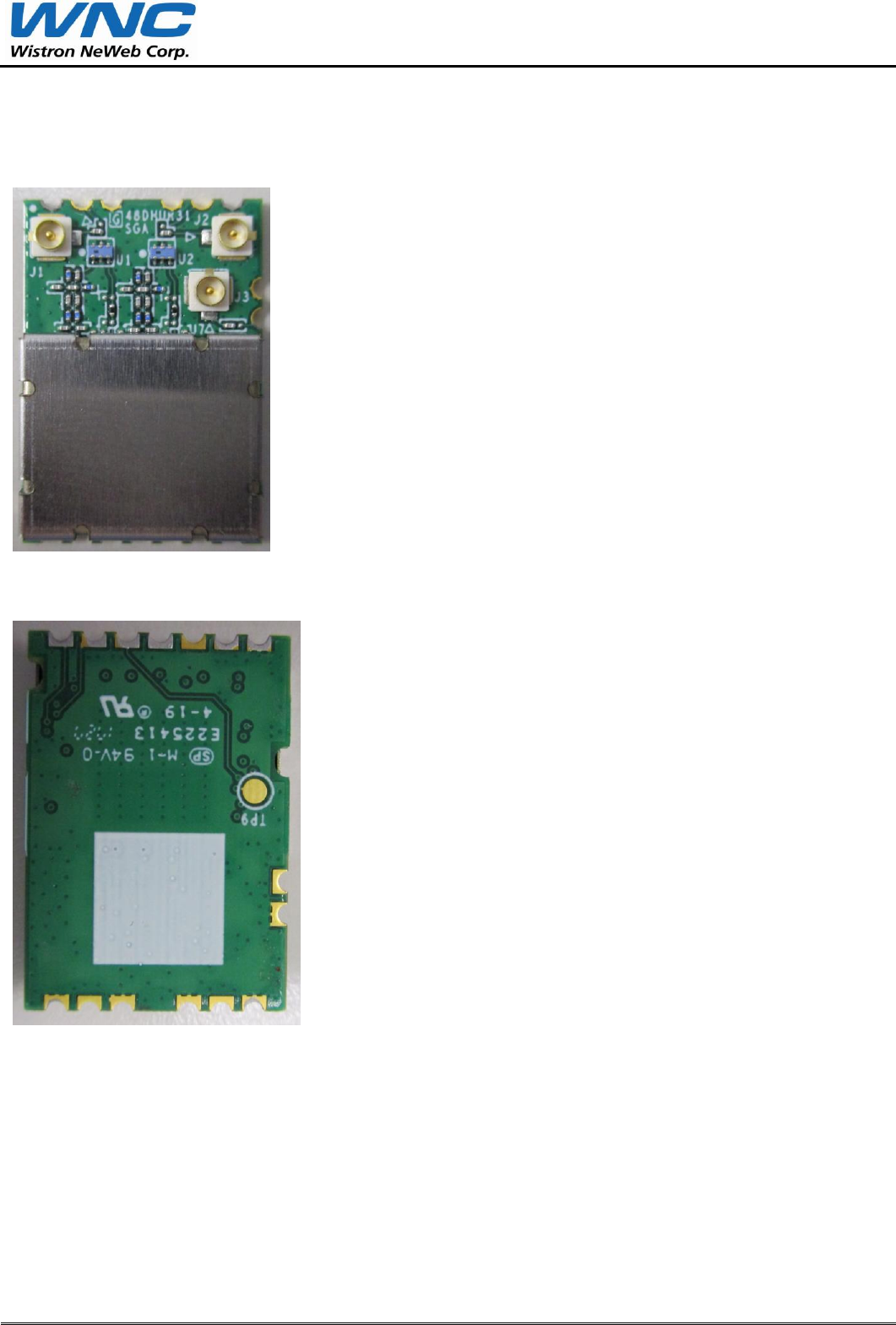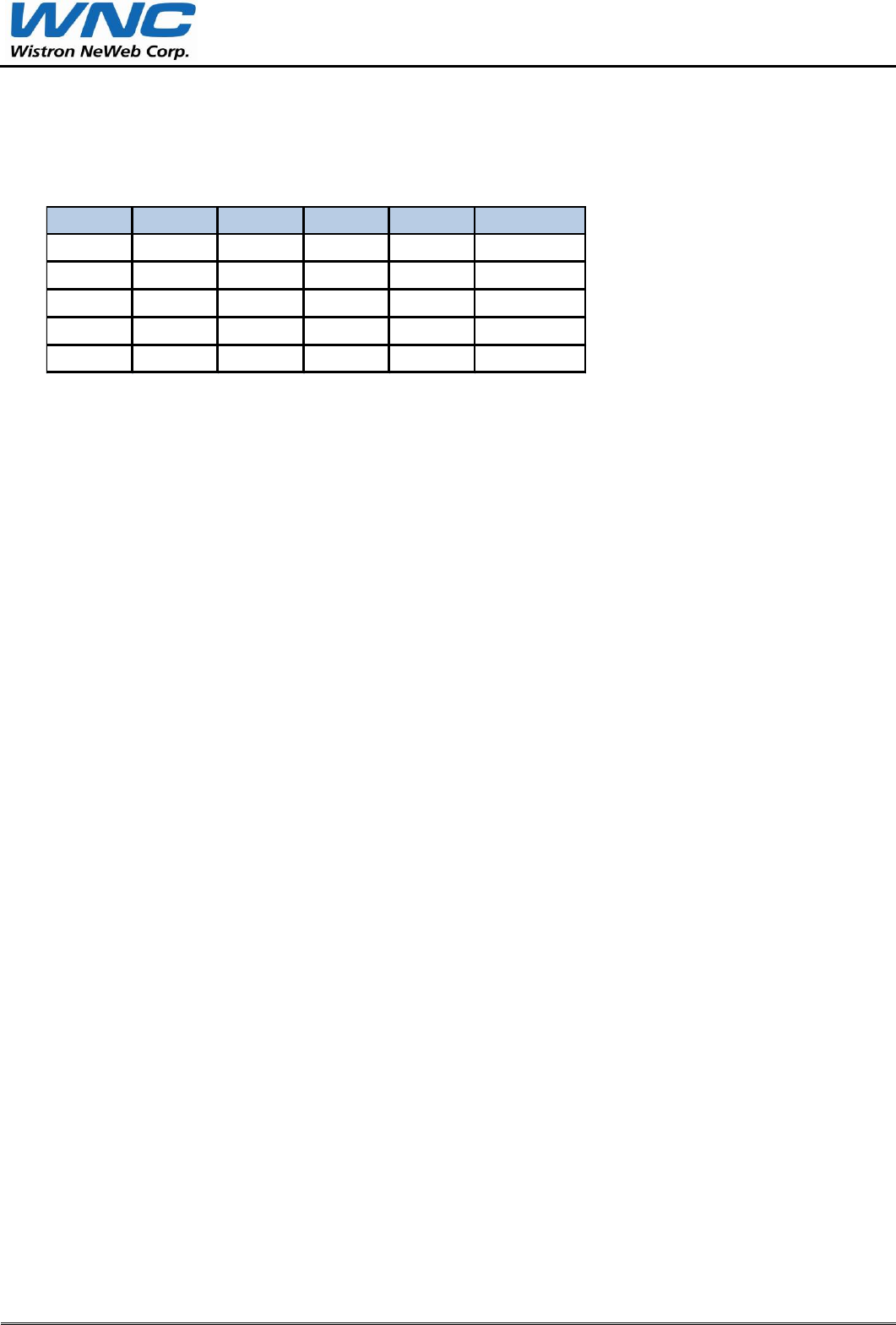Wistron NeWeb DHURAN32 STAMP module 802.11 abgn & BT User Manual Product Specifications
Wistron NeWeb Corporation STAMP module 802.11 abgn & BT Product Specifications
Users Manual
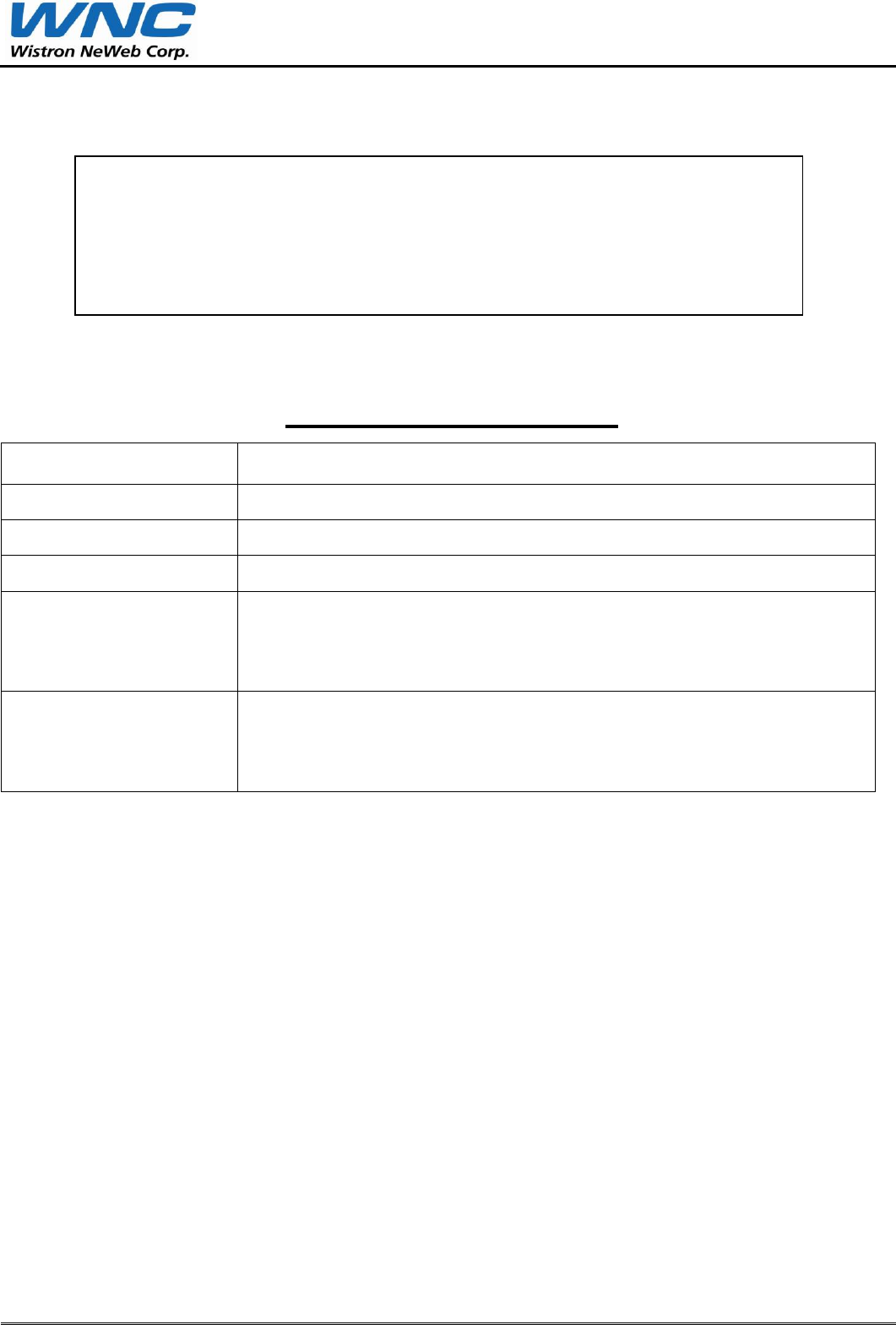
MODEL: DHUR-AN32
Confidential. Wistron Neweb Corporation
1 / 20
Date: 2017/07/28
Delivery Specifications
Product Description
STAMP module 802.11 abgn & BT
WNC Part Number
81DHUR31.G01
WNC Model Name
DHUR-AN32
Issue Version :
V1.1
Manufacturer
Wistron NeWeb Corporation (WNC)
Address: 20 Park Avenue II Road, Hsinchu Science Park, Hsinchu 308, Taiwan, R.O.C.
(ZIP Code: 308)
Tel: +886-3-666-7799
Production Factory
Wistron NeWeb (Kunshan) Corporation
Address: 789 Yujinxiang Road, Comprehensive Free Trade Zone, Kunshan City, Jiangsu
Province, P.R.C (ZIP Code: 215300)
Tel: 0086-512-5772-2688
User Manual
Model Name: DHUR-AN32
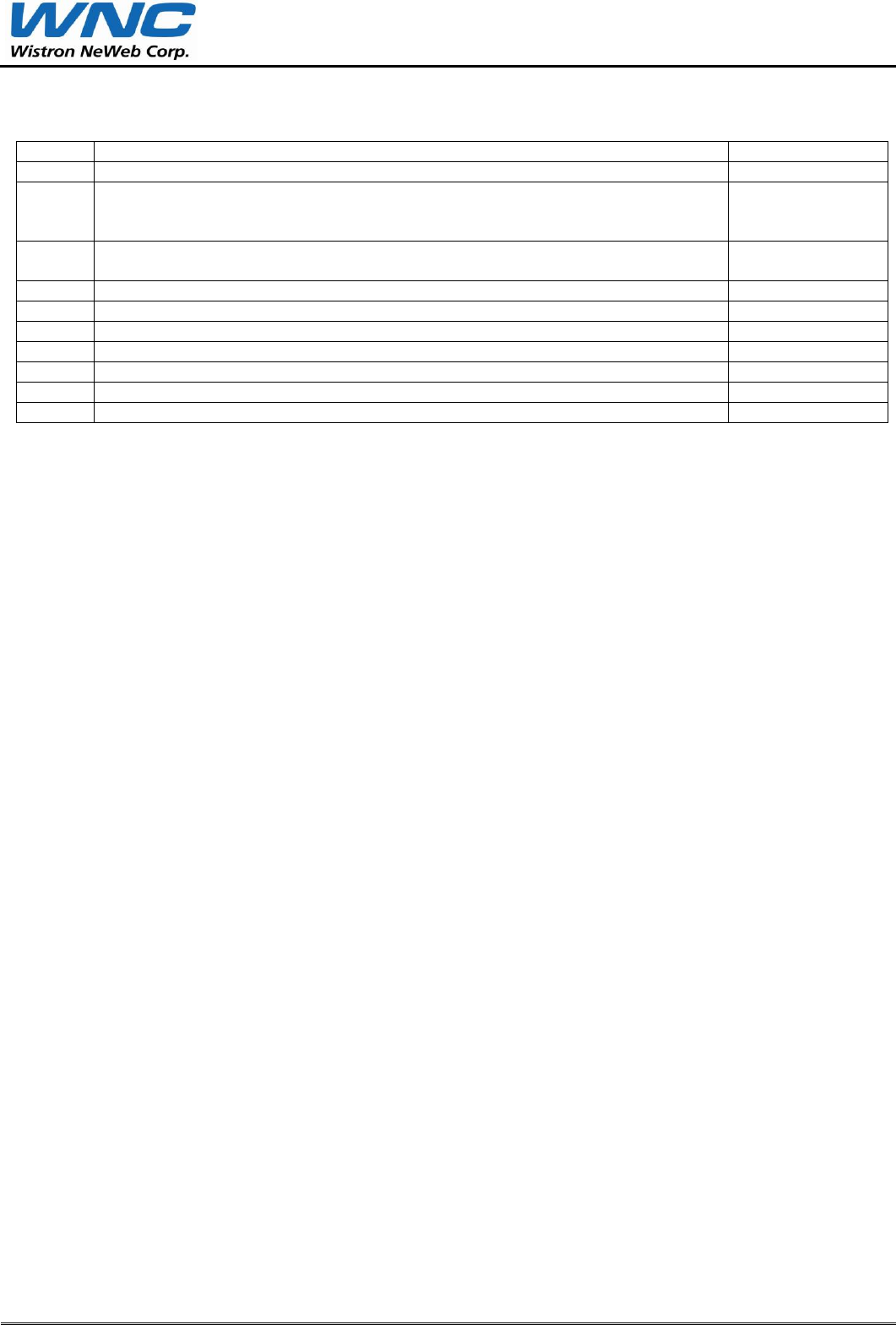
MODEL: DHUR-AN32
Confidential. Wistron Neweb Corporation
3 / 20
Revision History
Version
Change history
Date
1.0
Draft version
2017/07/06
1.1
1. Update Power-on Sequence Specifications in page 9
2. Module board thickness tolerance in page 21
3. Add EEPROM information in page 16
2017/07/13
1.2
4. Add Module Photo in page 4
5. Add Clamshell Embossed Carrier information in page 29
2018/07/19

MODEL: DHUR-AN32
Confidential. Wistron Neweb Corporation
4 / 20
Contents
1. Production Introduction ............................................................................................. 4
2. Photo Photograph ...................................................................................................... 5
3. Functional Block Diagram ......................................................................................... 6
4. I/O Pin Definition ......................................................................................................... 7
5. Product Specification ................................................................................................. 8
5.1 WiFi portion ............................................................................................................................................... 8
5.2 BT portion.................................................................................................................................................. 15
5.3 EEPROM Information ............................................................................................................................... 16
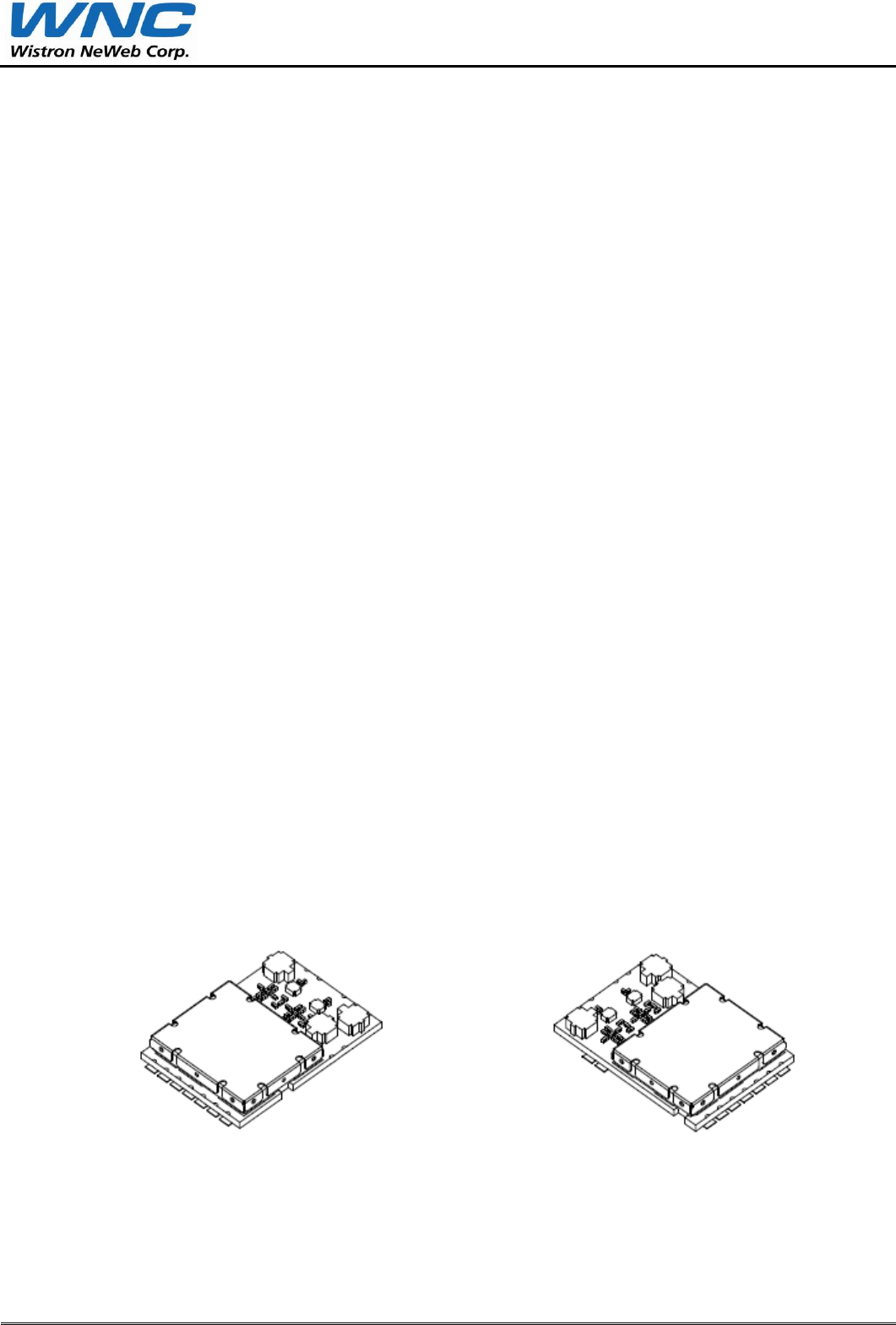
MODEL: DHUR-AN32
Confidential. Wistron Neweb Corporation
5 / 20
1. Product Introduction
DHUR-AN32 is a 802.11 a/b/g/n WLAN/Bluetooth Combo Module which compliant with
IEEE802.11n standard supports 2x2 a/b/g/n MIMO technology with data rate from MCS 0-15
in 20MHz/40MHz Channels, and BT4.2 LE specifications.
Features
Operation at 2.4~2.5GHz and 5.15~5.825GHz frequency band to meet worldwide
regulations
Bluetooth v4.2 Low Energy(LE);
Bluetooth specification v2.1+EDR;
Support wireless data encryption with 64/128-bit WEP for security
Drivers support Windows 2000,XP,Vista
ROHS compliant
Interfaces and Power supply
WLAN / Bluetooth RF interface
USB interface
Chip power down control
3.3V supply voltage
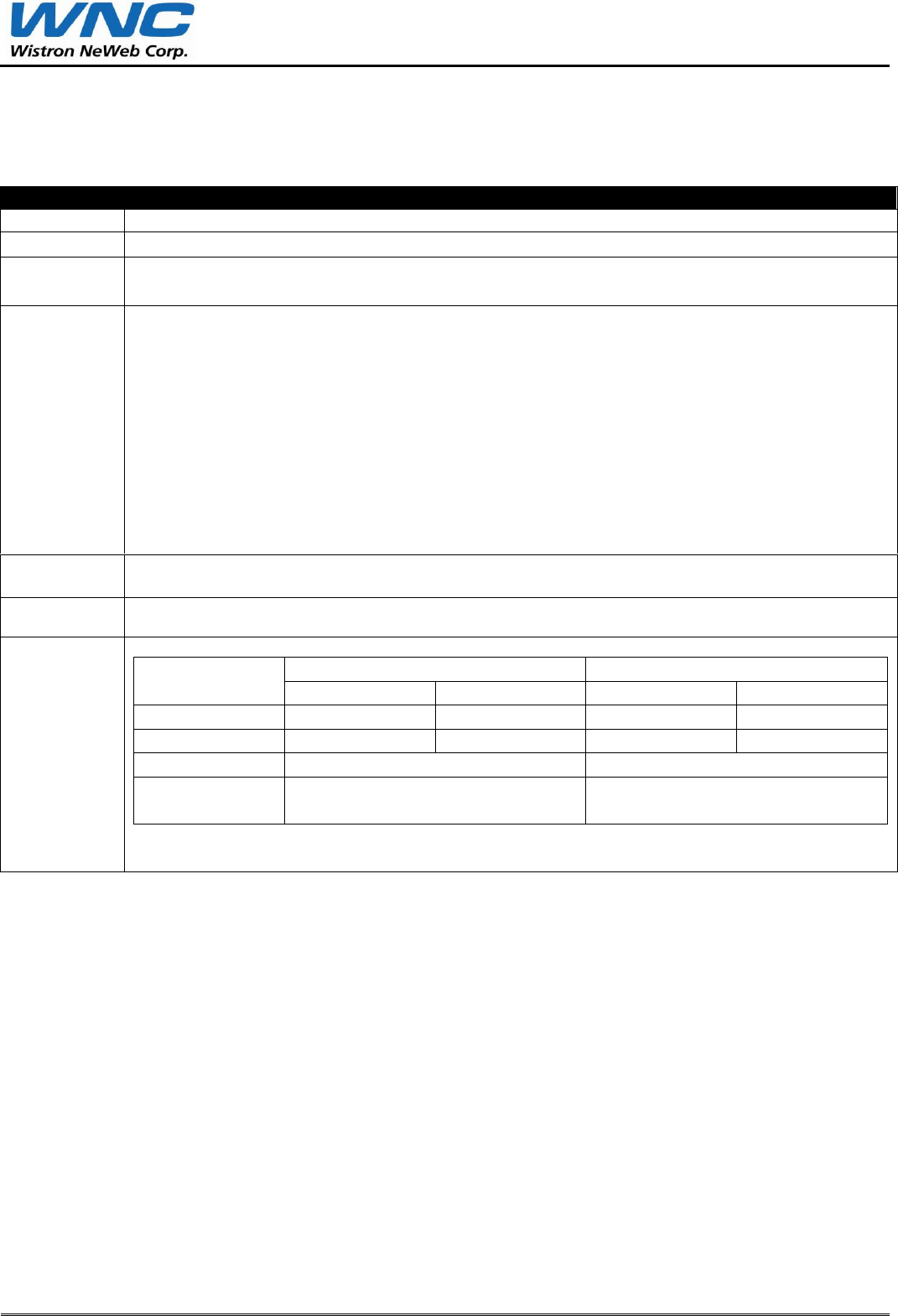
MODEL: DHUR-AN32
Confidential. Wistron Neweb Corporation
8 / 20
5. Product Specification
5.1 WiFi portion
Item
Key specifications
Main chipset
MTK MT7632TU
TX/RX
2T2R
Frequency
range
2.400 ~ 2.497GHz,5.15GHz ~ 5.85GHz
Modulation
technique
802.11 a/b/g
DSSS (DBPSK, DQPSK, CCK)
OFDM (BPSK, QPSK, 16-QAM, 64-QAM)
DSSS (Direct Sequence Spread Spectrum) with
DBPSK (Differential Binary Phase Shift Keying 1Mbps),
DQPSK (Differential Quaternary Phase Shift Keying 2Mbps), and
CCK (Complementary Code Keying 5.5&11Mbps), and
OFDM (Orthogonal Frequency Division Multiplexing with BPSK for 6,9Mbps、 QPSK for
12,18Mbps、 16QAM for 24,36Mbps、 64QAM for 48,54Mbps)
802.11n a/g
OFDM (BPSK, QPSK, 16-QAM, 64-QAM)
Host
interface
USB 2.0
Operation
voltage
3.3V DC +/-9% (including voltage ripple)
Power
consumption
@25 o C
Mode
Average
Peak
2.4G
5G
2.4G
5G
WiFi Tx
430mA
620mA
580mA
780mA
WiFi Rx
165mA
160mA
240mA
230mA
Driver disable
20mA
55mA
Standby
WiFi+BT
15mA
50mA
*WiFi Tx and Rx is for continuous Tx and Rx
**Power consumption measured on PC platform.

MODEL: DHUR-AN32
Confidential. Wistron Neweb Corporation
9 / 20
Output power
(for each
chain;
tolerance
+1.5/-1.5 dB)
802.11a
Test Frequencies 6-12_Target 18_Target 24_Target 36_Target 48_Target 54_Target
5180 14 14 14 14 14 14
5320 14 14 14 14 14 14
5500 14 14 14 14 14 14
5600 14 14 14 14 14 14
5700 14 14 14 14 14 14
5825 14 14 14 14 14 14
802.11b
Test Frequencies 1/2_Target 5.5_Target 11_Target
2412 15 15 15
2472 15 15 15
2484 15 15 15
802.11g
Test Frequencies 6-12_Target 18_Target 24_Target 36_Target 48_Target 54_Target
2412 14 14 14 14 14 14
2442 14 14 14 14 14 14
2472 14 14 14 14 14 14
802.11n
Freq. Range: HT20
Test Freq MCS 0/8 MCS 1/9 MCS 2/10 MCS 3/11 MCS 4/12 MCS 5/13 MCS 6/14 MCS 7/15
5180 12 12 12 12 12 12 12 12
5240 12 12 12 12 12 12 12 12
5320 12 12 12 12 12 12 12 12
5500 12 12 12 12 12 12 12 12
5700 12 12 12 12 12 12 12 12
5745 12 12 12 12 12 12 12 12
5825 12 12 12 12 12 12 12 12
Freq. Range: HT40
Test Freq MCS 0/8 MCS 1/9 MCS 2/10 MCS 3/11 MCS 4/12 MCS 5/13 MCS 6/14 MCS 7/15
5190 12 12 12 12 12 12 12 12
5230 12 12 12 12 12 12 12 12
5270 12 12 12 12 12 12 12 12
5510 12 12 12 12 12 12 12 12
5670 12 12 12 12 12 12 12 12
5755 12 12 12 12 12 12 12 12
5795 12 12 12 12 12 12 12 12
Freq. Range: HT20
Test Freq MCS 0/8 MCS 1/9 MCS 2/10 MCS 3/11 MCS 4/12 MCS 5/13 MCS 6/14 MCS 7/15
2412 14 14 14 14 14 14 14 14
2437 14 14 14 14 14 14 14 14
2472 14 14 14 14 14 14 14 14
Freq. Range: HT40
Test Freq MCS 0/8 MCS 1/9 MCS 2/10 MCS 3/11 MCS 4/12 MCS 5/13 MCS 6/14 MCS 7/15
2412 14 14 14 14 14 14 14 14
2437 14 14 14 14 14 14 14 14
2472 14 14 14 14 14 14 14 14
EVM
The transmit modulation accuracy is measured using error vector magnitude (EVM).
EVM is the magnitude of the phase difference as a function of time between an ideal reference
signal and the measured transmitted signal.
802.11a
Modulation
Code Rate
Relative constellation error (dB)
Relative constellation error (dB)
IEEE Spec (1Tx dB)
Typical (1Tx dB)
BPSK
1/2
-5
-20
BPSK
3/4
-8
-20
QPSK
1/2
-10
-22

MODEL: DHUR-AN32
Confidential. Wistron Neweb Corporation
10 / 20
QPSK
3/4
-13
-22
16-QAM
1/2
-16
-30
16-QAM
3/4
-19
-32
64-QAM
2/3
-22
-32
64-QAM
3/4
-25
-33
802.11b
Modulation
Code Rate
Relative constellation error (dB)
Relative constellation error (dB)
IEEE Spec (1Tx dB)
Typical (1Tx dB)
DBPSK
-10
-15
DQPSK
-10
-15
CCK
-10
-15
802.11g
Modulation
Code Rate
Relative constellation error (dB)
Relative constellation error (dB)
IEEE Spec (1Tx dB)
Typical (1Tx dB)
BPSK
1/2
-5
-20
BPSK
3/4
-8
-20
QPSK
1/2
-10
-20
QPSK
3/4
-13
-20
16-QAM
1/2
-16
-30
16-QAM
3/4
-19
-30
64-QAM
2/3
-22
-32
64-QAM
3/4
-25
-33
802.11ng(HT20)
Modulation
Code Rate
Relative constellation error (dB)
Relative constellation error (dB)
IEEE Spec (1Tx dB)
Typical (1Tx dB)
(MCS0) BPSK
1/2
-5
-20
(MCS1) QPSK
1/2
-10
-20
(MCS2) QPSK
3/4
-13
-20
(MCS3) 16-QAM
1/2
-16
-28
(MCS4) 16-QAM
3/4
-19
-30
(MCS5) 64-QAM
2/3
-22
-32
(MCS6) 64-QAM
3/4
-25
-32
(MCS7) 64-QAM
5/6
-27
-33
(MCS8) BPSK
1/2
-5
-20
(MCS9) QPSK
1/2
-10
-20
(MCS10) QPSK
3/4
-13
-20
(MCS11) 16-QAM
1/2
-16
-28
(MCS12) 16-QAM
3/4
-19
-30
(MCS13) 64-QAM
2/3
-22
-32
(MCS14) 64-QAM
3/4
-25
-32
(MCS15) 64-QAM
5/6
-27
-33
(HT40)
Modulation
Code Rate
Relative constellation error (dB)
Relative constellation error (dB)
IEEE Spec (1Tx dB)
Typical (1Tx dB)
(MCS0) BPSK
1/2
-5
-20
(MCS1) QPSK
1/2
-10
-20
(MCS2) QPSK
3/4
-13
-20
(MCS3) 16-QAM
1/2
-16
-28
(MCS4) 16-QAM
3/4
-19
-30
(MCS5) 64-QAM
2/3
-22
-32
(MCS6) 64-QAM
3/4
-25
-32
(MCS7) 64-QAM
5/6
-27
-33
(MCS8) BPSK
1/2
-5
-20
(MCS9) QPSK
1/2
-10
-20
(MCS10) QPSK
3/4
-13
-20
(MCS11) 16-QAM
1/2
-16
-28
(MCS12) 16-QAM
3/4
-19
-30
(MCS13) 64-QAM
2/3
-22
-32

MODEL: DHUR-AN32
Confidential. Wistron Neweb Corporation
11 / 20
(MCS14) 64-QAM
3/4
-25
-32
(MCS15) 64-QAM
5/6
-27
-33
802.11na(HT20)
Modulation
Code Rate
Relative constellation error (dB)
Relative constellation error (dB)
IEEE Spec (1Tx dB)
Typical (1Tx dB)
(MCS0) BPSK
1/2
-5
-20
(MCS1) QPSK
1/2
-10
-20
(MCS2) QPSK
3/4
-13
-20
(MCS3) 16-QAM
1/2
-16
-28
(MCS4) 16-QAM
3/4
-19
-30
(MCS5) 64-QAM
2/3
-22
-32
(MCS6) 64-QAM
3/4
-25
-32
(MCS7) 64-QAM
5/6
-27
-33
(MCS8) BPSK
1/2
-5
-20
(MCS9) QPSK
1/2
-10
-20
(MCS10) QPSK
3/4
-13
-20
(MCS11) 16-QAM
1/2
-16
-28
(MCS12) 16-QAM
3/4
-19
-30
(MCS13) 64-QAM
2/3
-22
-32
(MCS14) 64-QAM
3/4
-25
-32
(MCS15) 64-QAM
5/6
-27
-33
(HT40)
Modulation
Code Rate
Relative constellation error (dB)
Relative constellation error (dB)
IEEE Spec (1Tx dB)
Typical (1Tx dB)
(MCS0) BPSK
1/2
-5
-20
(MCS1) QPSK
1/2
-10
-20
(MCS2) QPSK
3/4
-13
-20
(MCS3) 16-QAM
1/2
-16
-28
(MCS4) 16-QAM
3/4
-19
-30
(MCS5) 64-QAM
2/3
-22
-32
(MCS6) 64-QAM
3/4
-25
-32
(MCS7) 64-QAM
5/6
-27
-33
(MCS8) BPSK
1/2
-5
-20
(MCS9) QPSK
1/2
-10
-20
(MCS10) QPSK
3/4
-13
-20
(MCS11) 16-QAM
1/2
-16
-28
(MCS12) 16-QAM
3/4
-19
-30
(MCS13) 64-QAM
2/3
-22
-32
(MCS14) 64-QAM
3/4
-25
-32
(MCS15) 64-QAM
5/6
-27
-33
Sensitivity
802.11a
Modulation
Code Rate
IEEE Spec (1Rx dBm)
Typical (1Rx dBm)
BPSK
1/2
-82
-88
BPSK
3/4
-81
-86
QPSK
1/2
-79
-84
QPSK
3/4
-77
-82
16-QAM
1/2
-74
-78
16-QAM
3/4
-70
-76
64-QAM
2/3
-66
-72
64-QAM
3/4
-65
-70
802.11b
Modulation
Code Rate
IEEE Spec (1Rx dBm)
Typical (1Rx dBm)
DBPSK
not specified
-92
DQPSK
not specified
-90
CCK
not specified
-86
802.11g
Modulation
Code Rate
IEEE Spec (1Rx dBm)
Typical (1Rx dBm)
BPSK
1/2
-82
-90
BPSK
3/4
-81
-88

MODEL: DHUR-AN32
Confidential. Wistron Neweb Corporation
12 / 20
QPSK
1/2
-79
-86
QPSK
3/4
-77
-84
16-QAM
1/2
-74
-82
16-QAM
3/4
-70
-78
64-QAM
2/3
-66
-74
64-QAM
3/4
-65
-72
802.11ng(HT20)
Modulation
Code Rate
IEEE Spec (1Rx dBm)
Typical (1Rx dBm)
(MCS0) BPSK
1/2
-82
-88
(MCS1) QPSK
1/2
-79
-86
(MCS2) QPSK
3/4
-77
-82
(MCS3) 16-QAM
1/2
-74
-80
(MCS4) 16-QAM
3/4
-70
-76
(MCS5) 64-QAM
2/3
-66
-73
(MCS6) 64-QAM
3/4
-65
-71
(MCS7) 64-QAM
5/6
-64
-69
(HT40)
Modulation
Code Rate
IEEE Spec (1Rx dBm)
Typical (1Rx dBm)
(MCS0) BPSK
1/2
-79
-86
(MCS1) QPSK
1/2
-76
-82
(MCS2) QPSK
3/4
-74
-80
(MCS3) 16-QAM
1/2
-71
-77
(MCS4) 16-QAM
3/4
-67
-74
(MCS5) 64-QAM
2/3
-63
-69
(MCS6) 64-QAM
3/4
-62
-68
(MCS7) 64-QAM
5/6
-61
-66
802.11na(HT20)
Modulation
Code Rate
IEEE Spec (1Rx dBm)
Typical (1Rx dBm)
(MCS0) BPSK
1/2
-82
-86
(MCS1) QPSK
1/2
-79
-84
(MCS2) QPSK
3/4
-77
-82
(MCS3) 16-QAM
1/2
-74
-80
(MCS4) 16-QAM
3/4
-70
-77
(MCS5) 64-QAM
2/3
-66
-71
(MCS6) 64-QAM
3/4
-65
-70
(MCS7) 64-QAM
5/6
-64
-69
(HT40)
Modulation
Code Rate
IEEE Spec (1Rx dBm)
Typical (1Rx dBm)
(MCS0) BPSK
1/2
-79
-84
(MCS1) QPSK
1/2
-76
-80
(MCS2) QPSK
3/4
-74
-78
(MCS3) 16-QAM
1/2
-71
-75
(MCS4) 16-QAM
3/4
-67
-71
(MCS5) 64-QAM
2/3
-63
-67
(MCS6) 64-QAM
3/4
-62
-66
(MCS7) 64-QAM
5/6
-61
-64
Transmit
spectrum
mask
For transmitted spectral mask for 11b shall be less than –50dBr for 22MHz<f<fc+22MHz.
For transmitted spectral mask for 11g shall be less than –40dBr for fc–30MHz<f<fc+30MHz.
For transmitted spectral mask for 11n 20MHz shall be less than –45dBr for
fc–30MHz<f<fc+30MHz.
For transmitted spectral mask for 11n 40MHz shall be less than –45dBr for
fc–60MHz<f<fc+60MHz.
Transmit
spectrum
flatness
For 802.11g the average energy of the constellations in each of spectral lines –16..-1
and +1..+16 will deviate no more than +/- 2dB from their average energy.
For 802.11n 40MHz mode, the average energy of the constellations in each of spectral
lines –42..-2 and +2..+42 will deviate no more than +/- 2dB from their average energy.
The transmitted spectral flatness should be with in +2/- 4dB.
Transmit
The transmitted center frequency tolerance shall be ±20 ppm maximum.

MODEL: DHUR-AN32
Confidential. Wistron Neweb Corporation
13 / 20
center
frequency
tolerance
Carrier
suppression
802.11a:
The leakage of the center frequency component shall not exceed -15 dB relative to
overall transmitted power or, equivalently, +2 dB relative to the average energy of the
rest of the sub-carriers.
802.11b:
The RF carrier suppression, measured at the channel center frequency, shall be at least
15 dB below the peak SIN(x)/x power spectrum.
802.11g:
The leakage of the center frequency component shall not exceed -15 dB relative to
overall transmitted power or, equivalently, +2 dB relative to the average energy of the
rest of the sub-carriers.
802.11n:
For all 20 MHz modes of transmission
The leakage of the center frequency component shall not exceed -15 dB relative to
overall transmitted power or, equivalently, +2 dB relative to the average energy of the
rest of the sub-carriers.
For all 40 MHz modes of transmission
The center frequency leakage shall not exceed -18 dB relative to overall transmitted
power, or, equivalently, +2 dB relative to the average energy of the rest of the sub-carriers.
Transmit
power on
ramp and
power down
ramp time
The transmitting power-on ramp for 10% to 90% of maximum power m shall be no greater than 2 µs.
The transmitting power-down ramp for 90% to 10% of maximum power shall be no greater than 2 µs.
Receiver
maximum
input level
802.11a
Modulation Code Rate IEEE Spec (1Rx dBm)
>-30
802.11b
Modulation IEEE Spec (1Rx dBm)
DBPSK >-10
DQPSK >-10
CCK >-10
802.11g
Modulation Code Rate IEEE Spec (1Rx dBm)
>-20
802.11na
Modulation Code Rate IEEE Spec (1Rx dBm)
>-30
802.11ng
Modulation Code Rate IEEE Spec (1Rx dBm)
>-20
PCB
dimension
16+/-0.1.mm x 23.00+/-0.1mm x 1.0+/-0.1mm 4L FR4
Transfer data
rate
802.11a: 6, 9, 12, 18, 24, 36, 48, 54Mbps
802.11b: 1, 2, 5.5, 11Mbps
802.11g: 6, 9, 12, 18, 24, 36, 48, 54Mbps
802.11n: @800GI(400GI)
20MHz BW
1 Nss: 65(72.2) Mbps maximal
2 Nss: 130(144.444) Mbps maximal
40MHz BW
1 Nss: 135(150) Mbps maximal
2 Nss: 270(300) Mbps maximal
1 Nss: 390(433.3) Mbps maximal
2 Nss: 780(866.7) Mbps maximal
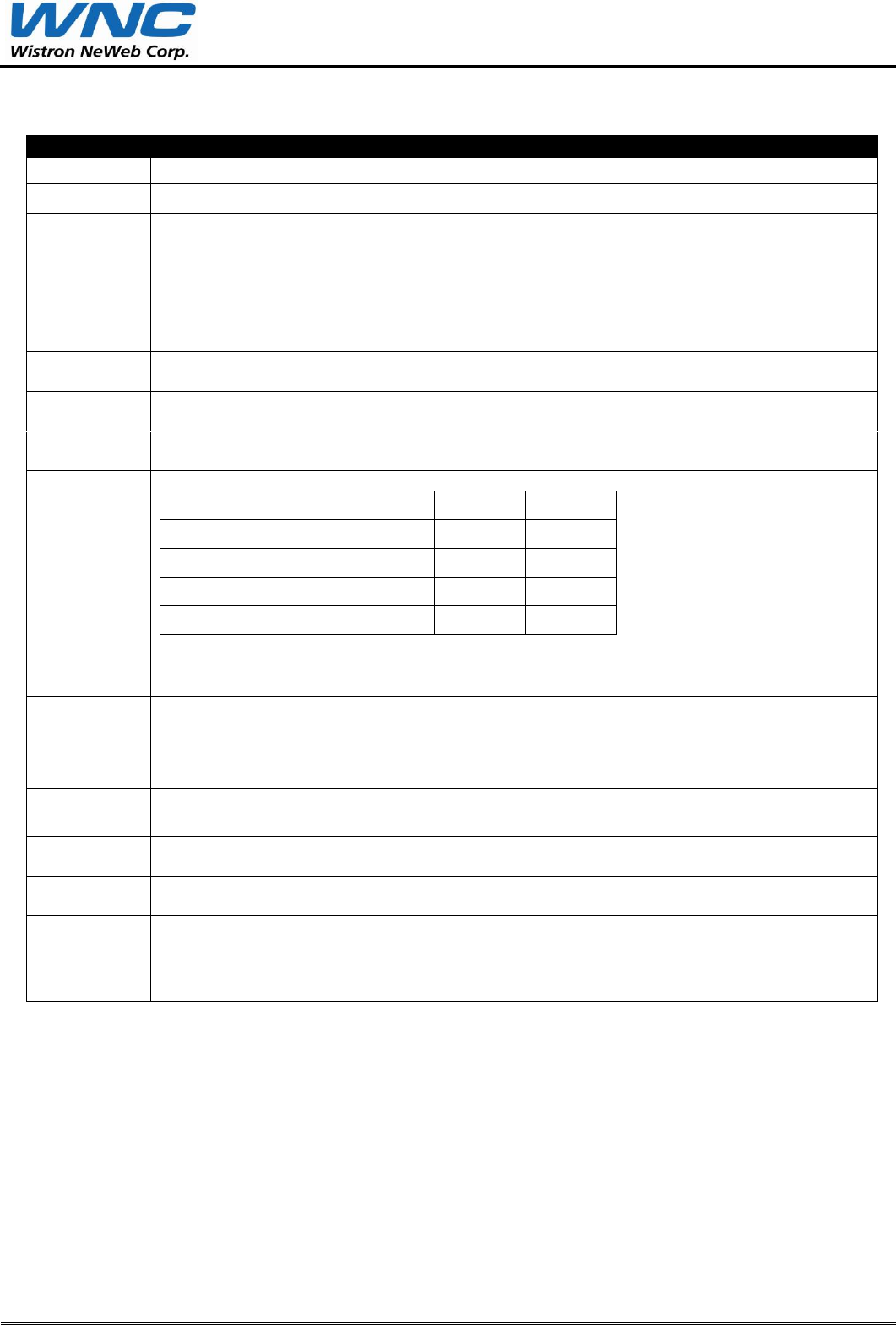
MODEL: DHUR-AN32
Confidential. Wistron Neweb Corporation
15 / 20
5.2 BT portion
Item
Key specifications
Main chipset
MTK MT7632TU
Compliance
Bluetooth v4.2 LE
Frequency
range
2400 ~ 2483.5MHz
Initial carrier
frequency
tolerance
+/- 40kHz (typical)
Modulation
technique
Frequency hopping, 1600 hops/sec
Channel
spacing
1MHz
Channels
support
79 channels
Operation
voltage
5V +/-9% (including voltage ripple)
Power
consumption
@25 o C
Avg (mA)
Max (mA)
Continuous DH5 TX
38
79
Continuous 2DH5 TX
36.5
72
Continuous 3DH5 TX
36.5
72
Continuous BLE TX
33.5
65
Note:
*BT Tx is for continuous Tx
**Power consumption measured on PC platform..
Output power
(dBm)
Class 1, BT output power is adjusted by FW .
Sensitivity
-85 dBm (typ.) for pi/4-DQPSK, 0.1%BER
Operation
temperature
-10o ~ 70o C
Storage
temperature
-35o ~ 70o C , R.H. : 90%
Antenna
1 I-PEX connector on module
PID/VID
PID: 76A1, VID: 0E8D

MODEL: DHUR-AN32
Confidential. Wistron Neweb Corporation
17 / 20
Federal Communication Commission Interference Statement
This equipment has been tested and found to comply with the limits for a Class B digital device,
pursuant to Part 15 of the FCC Rules. These limits are designed to provide reasonable protection
against harmful interference in a residential installation. This equipment generates, uses and can
radiate radio frequency energy and, if not installed and used in accordance with the instructions,
may cause harmful interference to radio communications. However, there is no guarantee that
interference will not occur in a particular installation. If this equipment does cause harmful
interference to radio or television reception, which can be determined by turning the equipment off
and on, the user is encouraged to try to correct the interference by one of the following measures:
● Reorient or relocate the receiving antenna.
● Increase the separation between the equipment and receiver.
● Connect the equipment into an outlet on a circuit different from that to which the receiver is
connected.
● Consult the dealer or an experienced radio/TV technician for help.
FCC Caution: Any changes or modifications not expressly approved by the party responsible for
compliance could void the user’s authority to operate this equipment.
This device complies with Part 15 of the FCC Rules. Operation is subject to the following two conditions: (1) This
device may not cause harmful interference, and (2) this device must accept any interference received, including
interference that may cause undesired operation.
This device is restricted for indoor use.
IMPORTANT NOTE:
FCC Radiation Exposure Statement:
This equipment complies with FCC radiation exposure limits set forth for an uncontrolled
environment. This equipment should be installed and operated with minimum distance 20cm
between the radiator & your body.
IMPORTANT NOTE:
This module is intended for OEM integrator. The OEM integrator is responsible for the
compliance to all the rules that apply to the product into which this certified RF module is
integrated.
Additional testing and certification may be necessary when multiple modules are used.
USERS MANUAL OF THE END PRODUCT:
In the users manual of the end product, the end user has to be informed to keep at least
20cm separation with the antenna while this end product is installed and operated. The end
user has to be informed that the FCC radio-frequency exposure guidelines for an
uncontrolled environment can be satisfied.
The end user has to also be informed that any changes or modifications not expressly
approved by the manufacturer could void the user's authority to operate this equipment.
If the labelling area is small than the palm of the hand, then additional FCC part 15.19
statement is required to be available in the users manual: This device complies with Part 15
of FCC rules. Operation is subject to the following two conditions: (1) this device may not
cause harmful interference and (2) this device must accept any interference received,
including interference that may cause undesired operation.
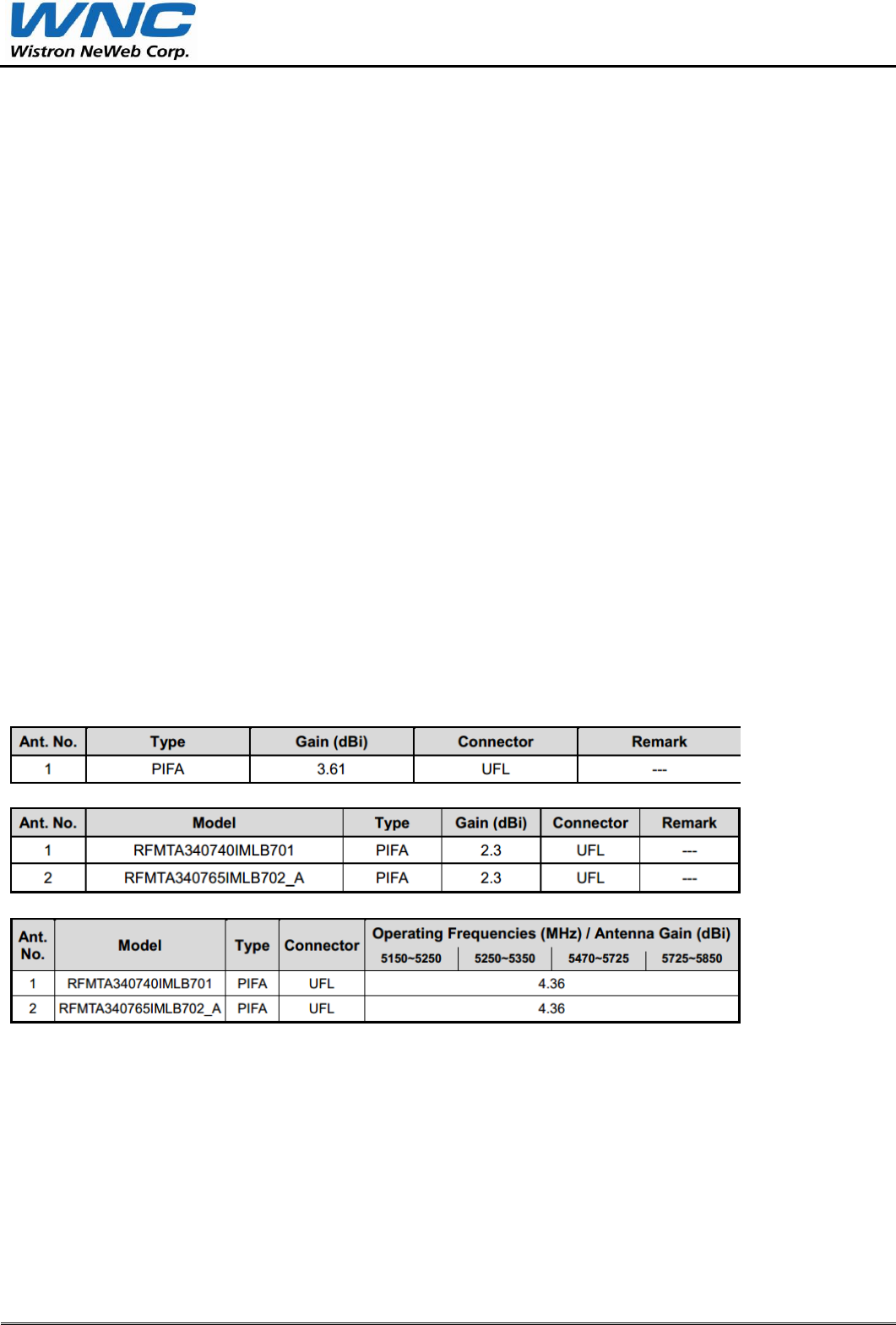
MODEL: DHUR-AN32
Confidential. Wistron Neweb Corporation
18 / 20
LABEL OF THE END PRODUCT:
The final end product must be labeled in a visible area with the following " Contains TX FCC
ID: NKR-DHURAN32 ".
If the labelling area is larger than the palm of the hand, then the following FCC part 15.19
statement has to also be available on the label: This device complies with Part 15 of FCC
rules. Operation is subject to the following two conditions: (1) this device may not cause
harmful interference and (2) this device must accept any interference received, including
interference that may cause undesired operation.
This device complies with Industry Canada license-exempt RSS standard(s). Operation is subject
to the following two conditions: (1) this device may not cause interference, and (2) this device must
accept any interference, including interference that may cause undesired operation of the device.
Le présent appareil est conforme aux CNR d'Industrie Canada applicables aux appareils radio exempts de
licence. L'exploitation est autorisée aux deux conditions suivantes : (1) l'appareil ne doit pas produire de
brouillage, et (2) l'utilisateur de l'appareil doit accepter tout brouillage radioélectrique subi, même si le
brouillage est susceptible d'en compromettre le fonctionnement.
This radio transmitter DHUR-AN32 has been approved by Industry Canada to operate with the
antenna types listed below with the maximum permissible gain indicated. Antenna types not
included in this list, having a gain greater than the maximum gain indicated for that type, are
strictly prohibited for use with this device.
Le présent émetteur radio DHUR-AN32 a été approuvé par Industrie Canada pour fonctionner avec les
types d'antenne énumérés ci-dessous et ayant un gain admissible maximal d'antenne. Les types d'antenne
non inclus dans cette liste, ou dont le gain est supérieur au gain maximal indiqué, sont strictement interdits
pour l'exploitation de l'émetteur.
Bluetooth
WIFI 2.4G
WIFI 5G
Dynamic Frequency Selection (DFS) for devices operating in the bands 5250- 5350 MHz, 5470-
5600 MHz and 5650-5725 MHz.
Sélection dynamique de fréquences (DFS) pour les dispositifs fonctionnant dans les bandes 5250-5350
MHz, 5470-5600 MHz et 5650-5725 MHz.
The device for operation in the band 5150–5250 MHz is only for indoor use to reduce the potential
for harmful interference to co-channel mobile satellite systems.
les dispositifs fonctionnant dans la bande 5150-5250 MHz sont réservés uniquement pour une
utilisation à l’intérieur afin de réduire les risques de brouillage préjudiciable aux systèmes de satellites
mobiles utilisant les mêmes canaux.
The maximum antenna gain permitted for devices in the bands 5250-5350 MHz and 5470-5725
MHz shall be such that the equipment still complies with the e.i.r.p. limit.

MODEL: DHUR-AN32
Confidential. Wistron Neweb Corporation
19 / 20
le gain maximal d’antenne permis pour les dispositifs utilisant les bandes 5250-5350 MHz et
5470-5725 MHz doit se conformer à la limite de p.i.r.e.
The maximum antenna gain permitted for devices in the band 5725-5850 MHz shall be such that
the equipment still complies with the e.i.r.p. limits specified for point-to-point and non-point-to-point
operation as appropriate.
le gain maximal d’antenne permis (pour les dispositifs utilisant la bande 5725-5850 MHz)
doit se conformer à la limite de p.i.r.e. spécifiée pour l’exploitation point à point et non point à point, selon le
cas.
Users should also be advised that high-power radars are allocated as primary users (i.e. priority
users) of the bands 5250-5350 MHz and 5650-5850 MHz and that these radars could cause
interference and/or damage to LE-LAN devices.
De plus, les utilisateurs devraient aussi être avisés que les utilisateurs de radars de haute puissance sont
désignés utilisateurs principaux (c.-à-d., qu’ils ont la priorité) pour les bandes 5250-5350 MHz et 5650-5850
MHz et que ces radars pourraient causer du brouillage et/ou des dommages aux dispositifs LAN-EL.
For indoor use only.
Pour une utilisation en intérieur uniquement.
IMPORTANT NOTE:
IC Radiation Exposure Statement:
This equipment complies with IC RSS-102 radiation exposure limits set forth for an uncontrolled
environment. This equipment should be installed and operated with minimum distance 20cm
between the radiator & your body.
Cet équipement est conforme aux limites d'exposition aux rayonnements IC établies pour un
environnement non contrôlé. Cet équipement doit être installé et utilisé avec un minimum de 20
cm de distance entre la source de rayonnement et votre corps.
IMPORTANT NOTE:
This module is intended for OEM integrator. The OEM integrator is responsible for the
compliance to all the rules that apply to the product into which this certified RF module is
integrated.
Additional testing and certification may be necessary when multiple modules are used.
Any changes or modifications not expressly approved by the manufacturer could void the
user's authority to operate this equipment.
USERS MANUAL OF THE END PRODUCT:
In the users manual of the end product, the end user has to be informed to keep at least
20cm separation with the antenna while this end product is installed and operated. The end
user has to be informed that the IC radio-frequency exposure guidelines for an uncontrolled
environment can be satisfied.
The end user has to also be informed that any changes or modifications not expressly
approved by the manufacturer could void the user's authority to operate this equipment.
Operation is subject to the following two conditions: (1) this device may not cause harmful
interference and (2) this device must accept any interference received, including
interference that may cause undesired operation.
LABEL OF THE END PRODUCT:

MODEL: DHUR-AN32
Confidential. Wistron Neweb Corporation
20 / 20
The final end product must be labeled in a visible area with the following " Contains IC:
4441A-DHURAN32 ".
The Host Model Number (HMN) must be indicated at any location on the exterior of the end
product or product packaging or product literature which shall be available with the end
product or online.
